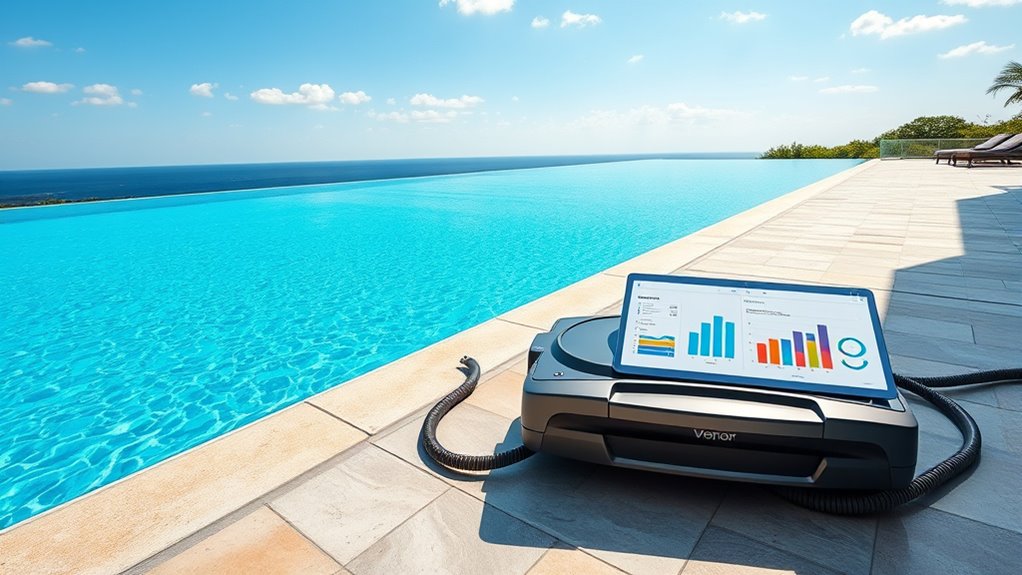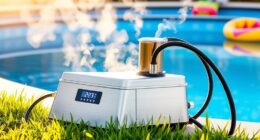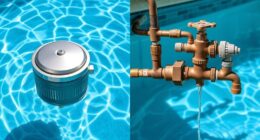To budget for long-term infinity pool maintenance, start by accounting for initial setup costs like construction, waterproofing, and equipment. Then, plan for regular expenses such as water treatment, cleaning, and routine repairs. Set aside a dedicated emergency fund for unexpected issues like leaks or equipment failures. Keep detailed records and review your budget annually to adjust for changing needs. If you want practical tips on managing costs effectively, continue exploring these essential strategies.
Key Takeaways
- Allocate a dedicated annual budget covering routine maintenance, component replacements, and unexpected repairs for the infinity pool.
- Track regular expenses and adjust your budget annually based on actual costs and emerging needs.
- Include funds for seasonal tasks like winterizing, cleaning, and landscaping adjustments to maintain pool aesthetics.
- Verify service provider costs, ensuring transparency and considering premium options for preventive maintenance and specialized repairs.
- Maintain an emergency reserve of 10-15% of the annual maintenance budget to cover unforeseen issues quickly.
Assessing Initial Investment and Ongoing Costs
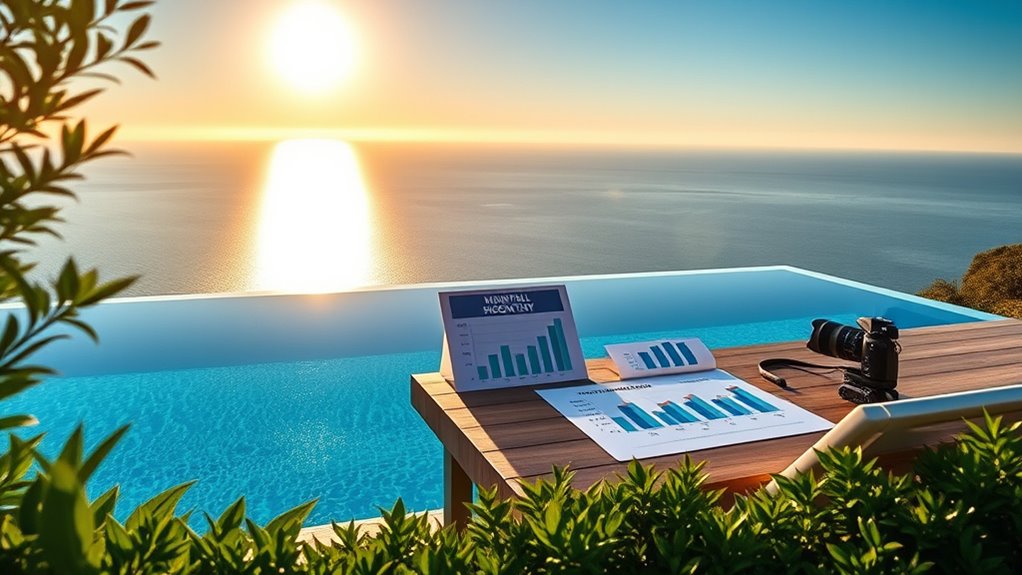
Before diving into the costs, it’s essential to comprehend both the initial investment and the ongoing expenses involved in maintaining an infinity pool. The initial costs can be significant, including excavation, construction, and specialized features like the infinity edge and waterproofing. You’ll also need to budget for pool equipment such as pumps, filters, and heating systems. Ongoing costs include electricity for running equipment, chemicals for water balance, and periodic repairs. Keep in mind that these expenses vary based on pool size, design complexity, and local labor rates. Planning for these upfront costs helps you set a realistic budget and avoid surprises down the line. Being aware of both initial and recurring expenses ensures you’re financially prepared for the long-term upkeep of your infinity pool. Additionally, considering water quality maintenance is crucial to keep the pool safe and inviting over time.
Understanding Regular Cleaning and Maintenance Needs
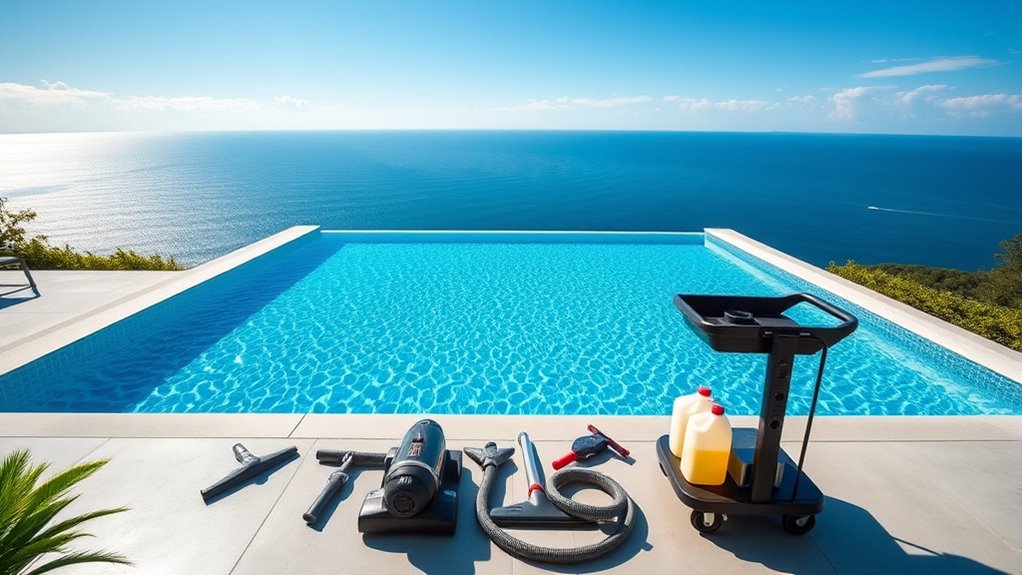
To keep your infinity pool in top shape, you need to prioritize regular water testing and equipment checks. Consistent testing guarantees water quality and safety, while scheduled inspections help catch issues early. By understanding these routine tasks, you can better plan your maintenance budget and avoid costly repairs down the line. Additionally, staying informed about modern slang and internet trends can help you communicate effectively with service providers or fellow pool owners who share your interests.
Routine Water Testing
How often should you test the water in your infinity pool? Ideally, you do it at least twice a week to keep everything balanced. Regular testing helps you catch issues early and avoid costly repairs later. Here’s what you should focus on:
- Check pH levels—aim for 7.2 to 7.6.
- Test chlorine or sanitizer levels—keep them within recommended ranges.
- Monitor alkalinity—should be between 80-120 ppm.
- Measure calcium hardness—avoid scale buildup by maintaining proper levels.
- Be mindful of water balance, as maintaining proper chemical levels is crucial to preserving the longevity of your pool and ensuring a safe swimming environment.
Scheduled Equipment Checks
Regularly scheduled equipment checks are essential to keep your infinity pool running smoothly and prevent unexpected breakdowns. You should inspect your pump, filter, and heater regularly to verify they’re functioning properly. Look for leaks, unusual noises, or decreased performance, which can indicate problems. Cleaning filters and removing debris from skimmers and pumps help maintain ideal flow. Additionally, check the control systems and sensors for accuracy. Performing these checks monthly or bi-weekly allows you to catch issues early and avoid costly repairs. Keeping detailed records of inspections and maintenance activities helps you stay on top of your budget and plan for replacements. Regular maintenance not only extends the lifespan of your equipment but also saves you money by preventing major failures. Incorporating Ford Tuning techniques can optimize your equipment performance and efficiency over time.
Planning for Water Treatment and Chemical Balance
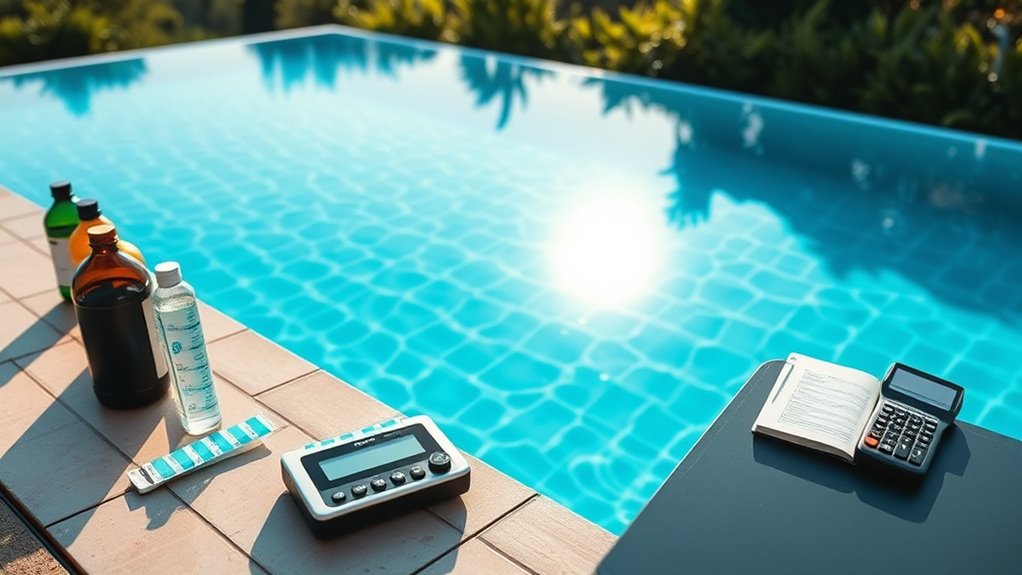
Maintaining proper water treatment and chemical balance is essential for keeping your infinity pool safe and inviting. To do this effectively, you need a clear plan. First, regularly test your water using a reliable kit to monitor pH, alkalinity, and sanitizer levels. Second, adjust chemicals promptly: add chlorine or bromine as needed to prevent bacteria growth. Third, keep an eye on stabilizers like cyanuric acid to protect your sanitizer from sunlight. Fourth, clean your skimmers and filters regularly to ensure proper circulation and chemical distribution. Fifth, consider the benefits of professional maintenance to ensure all aspects of your pool are properly managed. By staying consistent with these steps, you prevent issues like algae growth, cloudy water, and equipment damage. Proper planning helps you budget for chemicals and testing supplies, making long-term maintenance smoother and more cost-effective.
Budgeting for Routine Repairs and Component Replacements
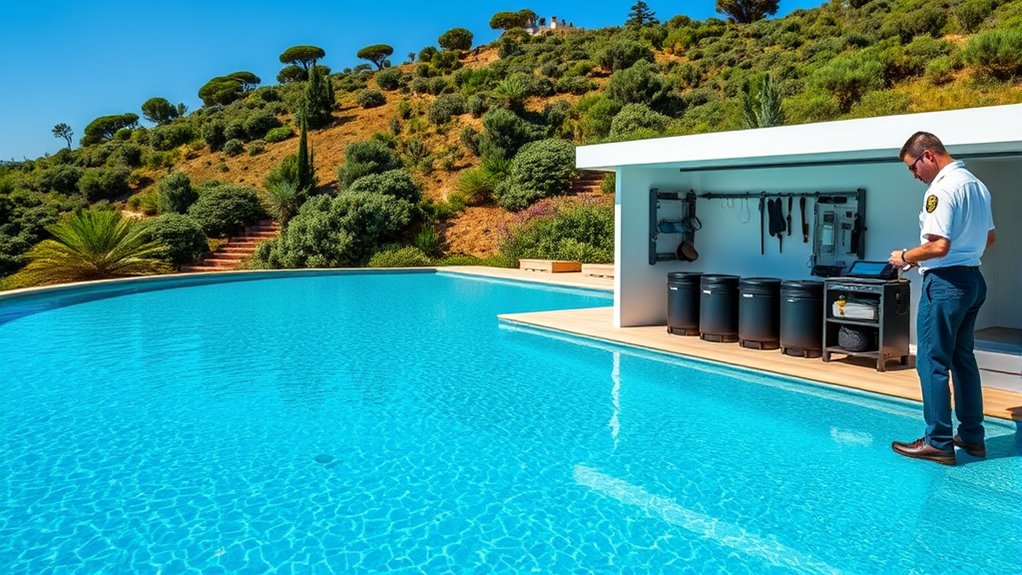
Proactively budgeting for routine repairs and component replacements guarantees your infinity pool stays in top condition without unexpected expenses. Regular maintenance prevents small issues from turning into costly repairs, keeping your pool safe and beautiful. Anticipate expenses like filter replacements, pump repairs, and jet adjustments. Setting aside a dedicated fund ensures you’re prepared for these inevitable costs. Understanding the importance of contrast ratio helps in assessing the overall performance and longevity of your pool’s filtration and lighting systems.
Considering Seasonal Maintenance and Upgrades

After setting aside funds for routine repairs and component replacements, it’s important to think about how seasonal changes impact your infinity pool. Seasonal shifts can cause wear and tear that requires proactive upgrades. Consider these factors:
- Prepare your pool for winter by adding freeze protection and inspecting the cover.
- Schedule cleaning and chemical balancing more frequently during hot months.
- Upgrade filtration systems or lighting to enhance aesthetics and efficiency.
- Address any landscaping or drainage adjustments needed to prevent debris buildup.
Planning for these seasonal tasks helps prevent costly damages later. By allocating funds now, you ensure your pool stays pristine and functional year-round. This proactive approach reduces emergency repairs and keeps maintenance predictable.
Estimating Long-Term Equipment Replacement Costs

Estimating long-term equipment replacement costs is essential for creating a realistic maintenance budget. You need to understand when major components, like pumps, filters, and heaters, will likely reach the end of their lifespan. Research typical replacement timelines based on manufacturer recommendations and your usage patterns. Factor in inflation and potential price increases over time to make sure your budget remains accurate. Set aside a designated reserve fund each year, calculated as a percentage of the replacement costs, to cover these future expenses. Additionally, considering the longevity of pool equipment can help you better plan for replacements and avoid unexpected costs. By proactively estimating these costs, you can avoid unexpected financial strain and plan for upgrades or replacements smoothly. This approach helps you maintain your infinity pool’s functionality and aesthetic appeal without disrupting your overall budget.
Finding Reliable Service Providers and Cost Comparisons

To guarantee your infinity pool stays in top shape, start by vetting service providers’ credentials to confirm their expertise. Next, compare their service packages to find options that fit your needs and budget. Finally, evaluate their pricing structures to avoid surprises and get the best value for your money.
Vet Professional Credentials
When choosing a service provider for your infinity pool, confirming their professional credentials is essential to guarantee reliable and quality work. Start by verifying their licensing—this assures they meet industry standards. Next, check for insurance; a reputable professional should have liability coverage to protect you from potential damages. Third, review their certifications or specialized training, which shows expertise in infinity pool maintenance. Finally, ask for references or past client reviews to gauge their reputation. These steps help you avoid unqualified providers, saving you money and frustration in the long run. Real Couples Understanding the importance of trustworthy professionals is crucial, especially when maintaining a luxury feature like an infinity pool. By vetting credentials thoroughly, you ensure your pool gets the best care while maintaining your budget’s integrity. Reliable professionals are an investment that pays off through quality, longevity, and peace of mind.
Compare Service Packages
Comparing service packages is essential to find a provider that offers the right balance of quality and affordability for your infinity pool. Start by gathering detailed information about what’s included in each package, such as cleaning, chemical balancing, equipment inspections, and emergency repairs. Look for transparency in pricing and clear descriptions of services. Don’t just focus on the lowest price—consider the value you’re getting for that cost. Some providers may include extras that save you money long-term, like preventive maintenance or priority scheduling. Reach out to multiple companies to ask about their offerings and compare their service scope. This process can help you identify providers that deliver reliable, exhaustive care without unnecessary expenses, ensuring your infinity pool stays pristine and well-maintained over time. Additionally, researching service reputation and customer reviews can give you insights into their reliability and quality of work.
Evaluate Pricing Structures
Are you confident that you’re accurately evaluating the true cost of different infinity pool service providers? To do this, compare pricing structures carefully. First, check if the quotes include all services you need, like cleaning, chemical treatments, and equipment checks. Second, ask about any hidden fees or extra charges for emergency visits or parts replacement. Third, consider the frequency of maintenance visits—more visits might mean higher costs but better upkeep. Fourth, evaluate the provider’s reputation for reliability and quality, not just price. By breaking down these factors, you’ll get a clearer picture of the true costs involved. This approach helps you avoid surprises and ensures you select a service provider that offers value and consistency over the long term.
Setting Aside Emergency Funds for Unexpected Repairs
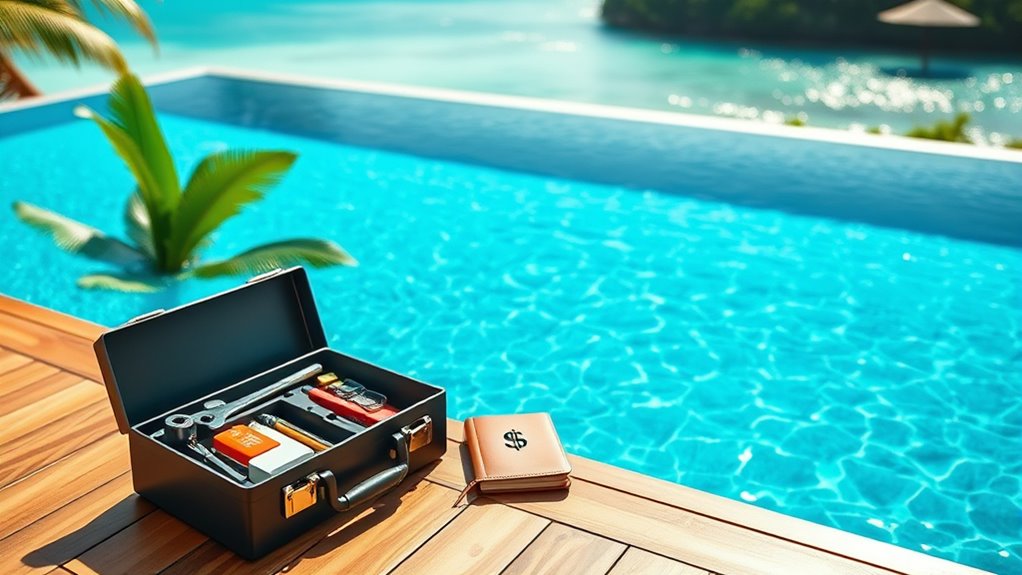
Setting aside emergency funds for unexpected repairs is a crucial step in maintaining your infinity pool without financial stress. No matter how well you plan, issues like pump failures, leaks, or electrical problems can arise suddenly. Having a dedicated emergency fund ensures you’re prepared to handle these surprises without disrupting your budget or delaying repairs. Aim to set aside at least 10-15% of your annual maintenance costs in a separate savings account. Regularly review and replenish this fund as needed, especially after making repairs. This proactive approach gives you peace of mind, knowing you’re financially ready for unforeseen problems. Building an emergency fund is a smart move to keep your infinity pool in top shape and your finances stable. Additionally, understanding environmental considerations can help you implement sustainable practices that may reduce future repair costs.
Tracking Expenses and Adjusting Your Budget Over Time
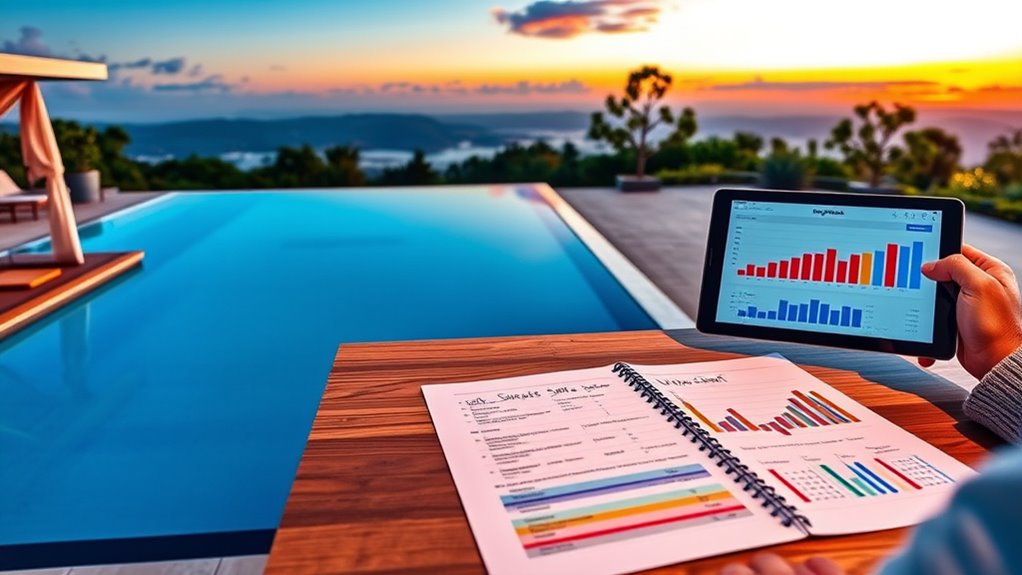
Keeping track of your expenses is essential to maintaining a realistic and effective budget for your infinity pool. Regularly monitoring your spending helps you identify patterns and adjust accordingly. Here’s how to do it:
- Record every maintenance expense, from cleaning supplies to repairs.
- Compare your actual costs against your budget monthly.
- Note any unexpected expenses that arise.
- Adjust your budget annually based on these insights to reflect actual costs.
Tips for Saving Money Without Compromising Quality
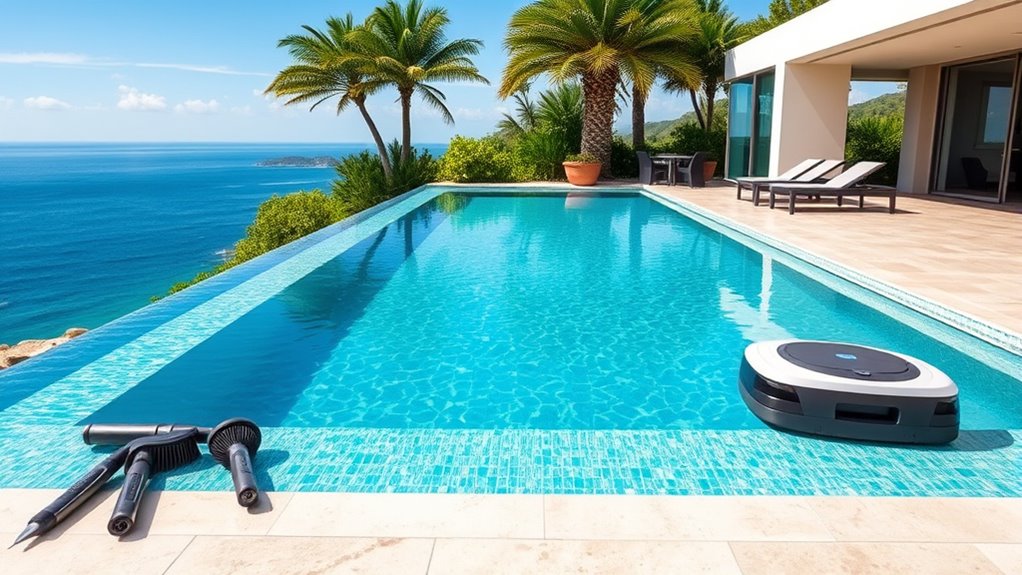
To save money without sacrificing quality, start by sticking to a regular maintenance schedule that keeps problems from escalating. Use high-quality supplies, which last longer and reduce the need for frequent replacements. Additionally, learn simple preventive care tricks you can do yourself to avoid costly repairs down the line.
Regular Maintenance Schedule
Establishing a regular maintenance schedule is essential to keep your infinity pool in top condition without overspending. Consistency prevents costly repairs and extends the lifespan of your pool. Here’s what to focus on:
- Check chemical levels weekly to avoid imbalance, which can cause damage.
- Skim debris daily to maintain water clarity and prevent clogging.
- Clean filters monthly to ensure proper circulation and reduce energy costs.
- Inspect the pool’s surface and equipment quarterly for signs of wear or leaks.
Use Quality Supplies
Choosing high-quality supplies for your infinity pool doesn’t mean you have to break the bank. Investing in durable, reliable products can save you money long-term by reducing replacement and repair costs. Instead of opting for the cheapest options, look for trusted brands that offer a good balance of affordability and longevity. For example, using high-quality filters, chemicals, and cleaning tools ensures your pool stays cleaner longer and minimizes maintenance issues. Here’s a quick comparison:
| Supply Type | Low-Quality Option | High-Quality Option |
|---|---|---|
| Pool Chemicals | Cheaper, quick-dissolving | Stable, long-lasting formulas |
| Filters | Frequent replacements | Durable, efficient filters |
| Cleaning Tools | Short lifespan | Heavy-duty, long-lasting tools |
| Cover Materials | Thin, easily torn | Thick, weather-resistant |
Prioritize quality to save money and keep your infinity pool pristine.
DIY Preventive Care
Maintaining your infinity pool’s quality doesn’t have to mean spending a fortune on repairs or professional services. By performing simple preventive tasks yourself, you can save money and keep your pool in top shape.
- Check and clean the skimmer baskets weekly to prevent debris buildup.
- Test the pH and chlorine levels regularly, adjusting as needed to avoid costly chemical imbalances.
- Inspect the pump and filter system for leaks or blockages, cleaning filters monthly.
- Brush the pool walls and tile line weekly to prevent algae and mineral deposits.
These small, consistent efforts help catch issues early, reducing the need for expensive repairs down the line. With a proactive approach, you’ll extend your pool’s lifespan while keeping maintenance costs manageable.
Frequently Asked Questions
How Often Should I Perform Routine Maintenance on My Infinity Pool?
You should perform routine maintenance on your infinity pool at least once a week. This includes skimming debris, checking water levels, testing chemical balance, and cleaning filters. During warmer months or heavy use, you might need to do this more often. Regular upkeep keeps your pool clean, safe, and functioning smoothly, preventing costly repairs down the line. Consistent maintenance guarantees your infinity pool remains a stunning, relaxing feature for years to come.
What Are the Most Cost-Effective Water Treatment Options?
You should opt for saltwater chlorination systems or mineral-based treatments, as they tend to be more cost-effective over time. These systems require less frequent chemical additions and reduce maintenance costs. Using a high-quality pool cover also minimizes water evaporation and debris, saving you money on water refills and cleaning. Regularly testing your water and maintaining proper chemical balance prevents costly repairs and guarantees your pool stays clean and safe.
How Can I Extend the Lifespan of Pool Equipment?
You can extend your pool equipment’s lifespan by regularly cleaning and inspecting it, replacing worn parts promptly, and maintaining proper water chemistry. Avoid neglecting filter cleaning and pump maintenance, as these are critical for efficiency. Use high-quality, compatible parts and follow manufacturer guidelines. Additionally, protect equipment from harsh weather and avoid overworking it. Consistent upkeep and timely repairs help prevent costly failures and keep your infinity pool running smoothly for years.
Are There Eco-Friendly Maintenance Practices for Long-Term Pools?
You can embrace eco-friendly practices for your long-term pool by using solar-powered pumps and energy-efficient filters that quietly hum like a gentle breeze. Choose biodegradable cleaning agents that won’t harm your surroundings, and install a cover to reduce water evaporation. Regularly test and balance your water naturally with mineral or enzyme treatments, ensuring your infinity pool remains stunning while minimizing your environmental footprint.
What Signs Indicate Imminent Repairs or Component Failures?
You should watch for cloudy or discolored water, which signals filtration issues. Listen for unusual noises from pumps or filters, indicating mechanical problems. Check for persistent leaks or cracks around the pool’s structure. If you notice a drop in water level despite no evaporation, it’s a sign of possible leaks. Additionally, sluggish or inconsistent jet flow and malfunctioning sensors suggest components may be failing soon. Address these signs promptly to prevent costly repairs.
Conclusion
By budgeting wisely for your infinity pool’s upkeep, you’re not just covering costs—you’re investing in endless luxury. Think of your budget as the steady hand guiding your pool’s future, turning maintenance from a chore into a seamless part of your paradise. With careful planning and smart choices, you’ll keep your oasis shimmering for years to come. After all, isn’t it worth every penny to enjoy a never-ending escape right in your backyard?
